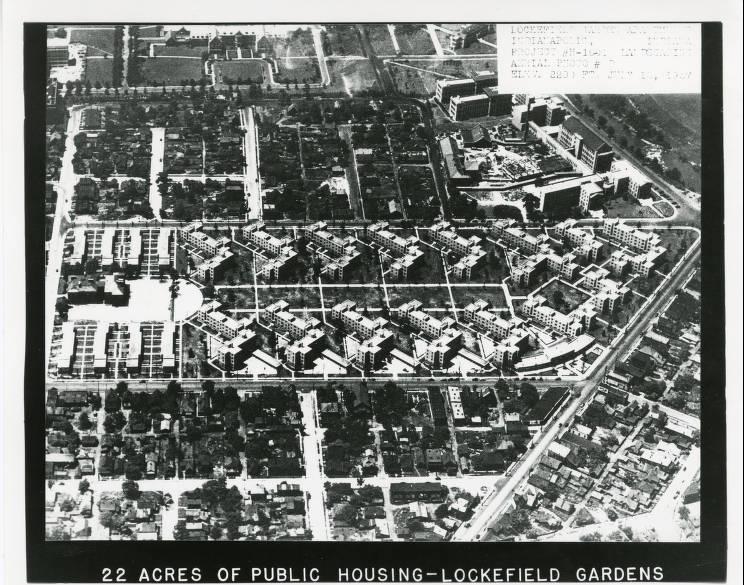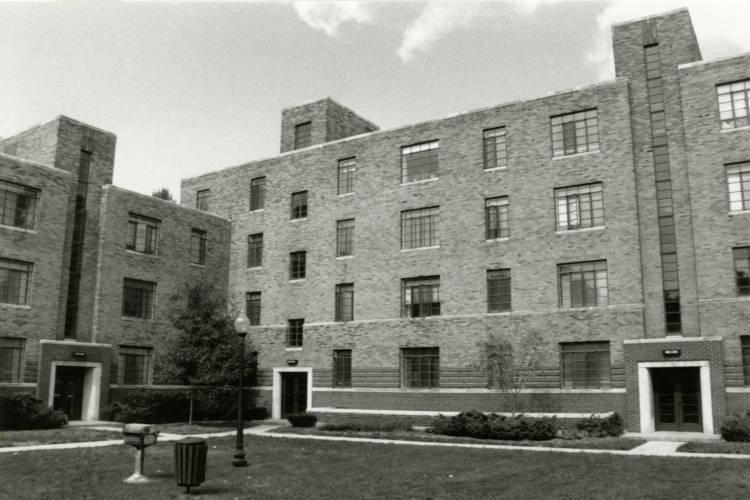Lockefield Gardens was the first major public housing project in Indianapolis. In the mid-1930s New Deal era, the federal Public Works Administration (PWA) made funds available for projects in about 20 states to clear slums and develop low-rent housing. The goals of the national program were to provide jobs in the hard-hit construction industry and improve the housing available to low-income citizens.

Under the program in Indianapolis, the firm of designed the development of 748 units on 22 acres bounded by and Blake, North, and Locke streets. It was considered one of the finest developments of its kind in the country. The land on which the complex was built was originally occupied by 363 residential structures. A contemporary report indicated that only one of the existing houses was habitable.
Based on the PWA Housing Division’s “strip,” “corner,” and “tee” models for public housing units, the development was marked by low-density apartment groups, high-quality construction, and plentiful natural light and ventilation. There were 24 buildings, two to four stories tall. The plan incorporated such amenities as spacious rooms, pleasant views, a central mall, a small shopping arcade within the complex, playgrounds, and an existing public school incorporated into the plan. The total cost of the project was approximately $3 million.

Opened in February 1938, Lockefield Garden Apartments offered comfortable apartments at a reasonable price. Monthly rents ranged from $20.80 for a three-room apartment to $30.10 for a four-room group house. Initially, Lockefield was racially segregated, but it offered Black residents a community-oriented place to live. The apartment complex formed the heart of the African American community just northwest of .
Within two years of opening, a Lockefield Gardens resident established an athletic league at the complex’s cinder and gravel basketball court. Known as the dust bowl, the court became a popular after-school spot for young African American basketball players growing up in the apartments. The popularity of the league resulted in the organizing a tournament there known as the which became an annual event, drawing thousands of spectators and creating a venue where African American youth developed athletic skills, sportsmanship, and a strong sense of community.
Lockefield Gardens maintained this central role until the 1950s when there was national pressure to make housing available to Blacks in what had traditionally been white residential areas. With new housing options open to more affluent members of the African American community, and with many residents being excluded from Lockefield by new income restrictions, the development gradually lost residents. Units became vacant, and the development fell into general disrepair. In the 1970s the city attempted to devise a redevelopment program for the complex, but federal Judge interpreted the plan as a means of perpetuating residential—and thus educational—segregation.
In 1980, as part of a general proposal billed as a revitalization of Indiana Avenue, the neighborhood-based Midtown Economic Development Industrial Corporation (MEDIC), IUPUI, and agreed to a plan to vacate some of the lands the development occupied, primarily for the expansion of the university. Under this plan, all but seven of the original buildings would be demolished, replaced with new construction, and the remaining original buildings renovated.
Despite determined opposition from local preservationists and interested citizens, the demolition occurred in 1983. The 7 remaining original buildings were designated as an official Indianapolis historic district that same year (see ). They were rehabilitated, and 11 new buildings were constructed with 493 total units, 199 of which are in the historic structures.

Help improve this entry
Contribute information, offer corrections, suggest images.
You can also recommend new entries related to this topic.